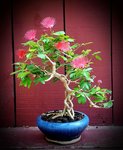It all depends upon how delicate or tough the species is. Next, is what situation is the root system in, bare root naturally needs go to straight into a growing season, potted 4" (10cm) would be more problematic than 1 gal (4 lt). Where it's coming from is very important, too. Coming from an equal growing zone is less stressful than from a warmer, longer season zone. How you intend to winter it over can make the difference between easy or hard winter. Inside a outbuilding that never gets too warm, especially in spring is favored by some, but bringing it back out in spring when the plant has satisfied the rest period days before the weather gets pleasant enough for the tree to stay out overnight forces you to move the tree twice a day. An area protected from winds outdoors is helpful, and mulching with leaves is good for most hardy species, but again it depends on your zone and how solidly the tree fits your zone. If a tree is rated zone 3 to 8 and you are a 3 or an 8 that's more problematic than if you are a 4 to 7, etc. Setting the tree on bare ground and mulching with leaves up over the edge of the pot is not as protective as sinking the pot in the soil up to the edge of the pot and mulching, but most don't have to do that, only those places with severe winters with ground temps that fall below 15/20°F (-10°C).
Most people should start with potted plants from a local landscape nursery which are cheaper and more likely to be hardy to your zone. They are already in a container, have been for some time, and it's plastic and won't break. Messing with roots immediately before plants go to sleep is a bad practice. They can go to sleep and never wake up. Buying the less hardy plants shipped in spring when the weather permits putting the plant immediately in growing situation is less likely to fail. Buying locally very late in the season gets cheap plants, but you are assuming the risk that the seller didn't want, so that's a trade-off.

